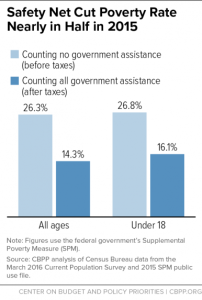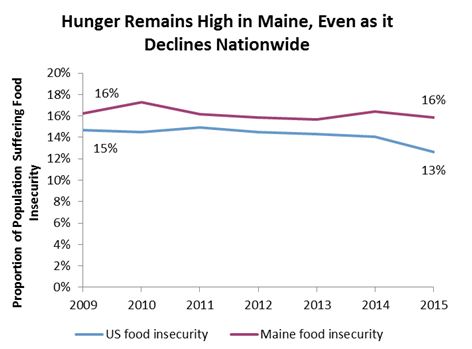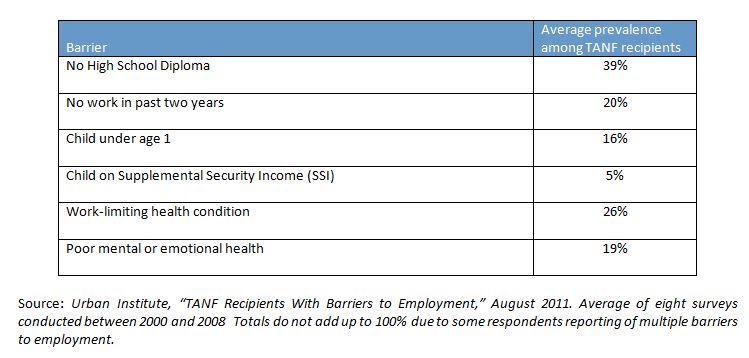The governor’s budget proposal presents you with a series of false choices – between protecting the most vulnerable elderly and disabled Mainers, and providing health care for those in poverty; between helping Mainers into work and providing them with government assistance. The truth is that Maine doesn’t have to pit one group of our needy friends and neighbors against another. The governor’s budget looks to cut these programs for one reason – to pay for tax cuts that disproportionately benefit the wealthy. Tax cuts that would result in most Mainers paying more, in exchange for a giveaway of $24,000 for the wealthiest 1%.
For a PDF of this testimony as delivers, click here.
Good afternoon, Senators Hamper and Brakey, Representatives Gattine and Hymanson, and members of the Appropriations and Financial Affairs and the Health and Human Services Committees. My name is James Myall, a policy analyst at the Maine Center for Economic Policy. I am here to testify in opposition the governor’s proposed budget, concerning cuts to the state’s assistance programs for low-income Mainers. The Supplemental Nutrition Assistance Program (SNAP), Temporary Aid for Needy Families (TANF), and General Assistance (GA) programs provide vital resources for thousands of struggling Mainers every year. These proposed changes would stand in the way of building thriving communities and a strong Maine economy. Investing in families lays the foundations for a strong economy. The governor’s budget cuts taxes for the rich, and to pay for that priority, causes more hardship for Maine’s working families, New Mainers, and seniors. If we want Maine’s economy to succeed, and to work for everyone, we need to be helping these families, not punishing them.
 We know that anti-poverty measures work. Nearly 40 million Americans who would otherwise be living in poverty are helped by anti-poverty programs, including those the budget proposes to slash. The poverty rate would be almost twice as high without the impact of SNAP, TANF, and other programs.[1] What’s more, even for those families who remain in poverty, food and other basic assistance provide a lifeline, making the difference between chronic and persistent poverty, and a chance at a better life. In 2012, the SNAP program alone lifted more than 2 million American children out of deep poverty (living below 50% of the federal poverty level). The proposed changes only make it more difficult for these programs to help Maine families – by snatching away the safety net for relatively minor transgressions; by punishing children for the actions of their parents; and by limiting the time for which assistance is available.
We know that anti-poverty measures work. Nearly 40 million Americans who would otherwise be living in poverty are helped by anti-poverty programs, including those the budget proposes to slash. The poverty rate would be almost twice as high without the impact of SNAP, TANF, and other programs.[1] What’s more, even for those families who remain in poverty, food and other basic assistance provide a lifeline, making the difference between chronic and persistent poverty, and a chance at a better life. In 2012, the SNAP program alone lifted more than 2 million American children out of deep poverty (living below 50% of the federal poverty level). The proposed changes only make it more difficult for these programs to help Maine families – by snatching away the safety net for relatively minor transgressions; by punishing children for the actions of their parents; and by limiting the time for which assistance is available.
In 2015, for every 100 poor families with children in Maine, only 24 received TANF cash assistance – compared to 62 percent of poor families in the 1990s.[2] This is the result of systematic actions to weaken the TANF program, and improperly redirect money elsewhere. Maine has underspent its federal block grant by more than $150 million over the past several years, and continues to underspend at a rate of $30 million annually.[3] Yet poverty and hunger are on the rise in Maine. While the rest of the nation has seen declines in poverty and the need for assistance as a result of the ongoing economic recovery, Maine families continue to suffer from hunger and other results of poverty. An additional 5,000 Mainers have fallen into poverty since 2010.[4] One in six Mainers remains food insecure. A study conducted by the Preble Street Maine Hunger Initiative and Good Shepherd Food Bank in 2015 found that one in four food pantry users in Maine had received SNAP in the past, but no longer qualified.[5] Many of these had lost their assistance due to recent rules changes by the administration but remained hungry and in need of help. Cutting safety net programs does not alter the reality of hunger and poverty in Maine. Previous cuts to the safety net have hurt Maine families, and the proposed changes in this budget will only worsen the situation.

MECEP analysis of US Census Bureau, Current Population Survey, Food Security Supplement data. Maine data are 3-year averages to improve reliability.
Contrary to what members of the committee may have heard, SNAP improves children’s nutrition. A study of children’s access to the food stamp program showed that it reduces malnutrition, heart disease, and obesity rates, and has a significant impact on high school completion rates. Hungry children cannot learn, just as hungry adults find it harder to stay employed, find a job, or enter into training. The first comprehensive study of its kind last year found that grocery purchases by food stamp recipients were largely the same as those of other households (see attached).[6] For SNAP and non-SNAP households alike, 40% of all purchases were for basic necessities like meat, fruit, vegetables and bread, and another 40% for cereals, beans, rice and dairy foods. Only 20 cents of every SNAP dollar was spent on snacks or sweetened drinks – which is the same proportion as in non-SNAP households. Efforts to combat obesity would be better targeted at education of the general population than singling out low-income Mainers.
The proposed restrictions and sanctions for TANF, SNAP and General Assistance do not recognize the reality of economic cycles, and the situation faced by the tens of thousands of Mainers who use the assistance programs. National studies find significant barriers to employment among TANF recipients, which range from child care needs to lack of education, or the presence of a long-term health condition which makes work difficult. TANF recipients are also more likely to be suffering from mental health conditions, including substance use disorder, and domestic violence.[7] Most TANF recipients have one such significant barrier to employment, while a third may have two or three such obstacles to overcome. Families want to overcome these difficulties, and government assistance programs can play a crucial role in helping them to do so. We should be strengthening the social safety net, not adding a new source of stress by cutting it.

Source: Urban Institute, “TANF Recipients With Barriers to Employment,” August 2011. Average of eight surveys conducted between 2000 and 2008 Totals do not add up to 100% due to some respondents reporting of multiple barriers to employment.
The governor’s budget proposal presents you with a series of false choices – between protecting the most vulnerable elderly and disabled Mainers, and providing health care for those in poverty; between helping Mainers into work and providing them with government assistance. The truth is that Maine doesn’t have to pit one group of our needy friends and neighbors against another. The governor’s budget looks to cut these programs for one reason – to pay for tax cuts that disproportionately benefit the wealthy. Tax cuts that would result in most Mainers paying more, in exchange for a giveaway of $24,000 for the wealthiest 1%.[8] I urge you to reject these unnecessary spending reductions, and to choose to invest in Maine’s people and communities, instead of handouts for the 1%. Thank you. I’ll be happy to answer any questions.
[1] http://www.cbpp.org/research/poverty-and-inequality/chart-book-accomplishments-of-the-safety-net#part1
[2] http://www.cbpp.org/sites/default/files/atoms/files/tanf_spending_me.pdf
[3] http://bangordailynews.com/2016/07/22/opinion/editorials/maine-leaves-more-welfare-money-unspent-as-more-children-fall-into-poverty/
[4] US Census Bureau, American Community Survey 1-year estimates, 2010 and 2015.
[5] https://www.gsfb.org/wp-content/uploads/2017/02/Food-Pantry-Report-2-6-171.pdf
[6] https://www.fns.usda.gov/sites/default/files/ops/SNAPFoodsTypicallyPurchased.pdf v
[7] http://www.urban.org/sites/default/files/publication/25396/412567-TANF-Recipients-with-Barriers-to-Employment.PDF
[8] https://www.mecep.org/lepage-budget-raises-taxes-for-mainers-making-less-than-92000-gives-huge-tax-cut-to-top-1/


